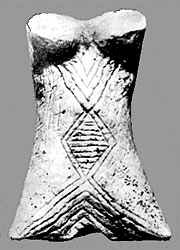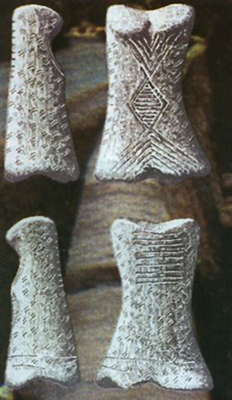From https://en.wiktionary.org/wiki/Reconstruction:Proto-Indo-European/h%E2%82%81er- Etymology. Of unknown origin. Possibly a late West Central Indo-European dialectal word. Within Nostratic framework derived from Proto-Nostratic *ʔer-a (“earth, ground”) (Bomhard 2015) or *ʔarV̄ (“earth, land, place”) (Dolgopolsky) with cognates such as:
- Proto-Afro-Asiatic*ʔ[e]r-t͜ɬ’ (“earth, ground”): Proto-Semitic *ʾarṣ́-, West Chadic *HVrit͜ɬ’- (“earth”), East Chadic *ʔirt͜ɬ’- (“valley”).
- Dravidian: Kannada [script needed](ere, “black soil”), Telugu రేగడ (rēgaḍa), రేగడి (rēgaḍi, “clay”), (prefixed forms of గడ్డ (gaḍḍa, “clod”))
Root *h₁er- 1.earth
- Ancient Greek :*ἔρα (*éra) in ἔραζε (éraze, “on the ground”) and compounds
- From https://en.wiktionary.org/wiki/Reconstruction:Proto-Indo-European/h%E2%82%82er-Proto-Indo-European
Root *h₂er-
- to fit, to fix, to put together
- Ancient Greek:ὄρος (óros) -----------------------------------------------------------------------------------------------------
- These three roots (wich are not much different) are the roots of the basic and of paramount importance things (with same numbers and order):
- 1. h1er/EARTH (related to Earth-Mother and agriculture)
- 2. h2er/ religion Chartus concept (wich has the root char)
- 3, h3er/tiling,turning the earth upside-down=plowing, and the sky-sacred mountain Note. There are research papers where is sustained that Horus,Horos, Hora, ora, Hera are close-related (probably through pre-Indo-European languages) ------------------------------------------------------------------------------------------------------------------
- From Proto-Indo-European Religion http://www.ceisiwrserith.com/pier/whatwasreligion.htm
- "Rather than go into the deities, though, I would like to concentrate here on two principles. These interact with each other, but I will try to explain them separately.The first is what I call the ghosti-principle. *ghostis is a PIE word which means "one with whom one has a reciprocal obligation of hospitality." ....The second is the *Xartus, which is the pattern of the universe. This word comes from the root *xar-, meaning "to fit together, particularly according to a pleasing pattern." Both linguistically and ideologically Xartus is the root of the Vedic rta, and the concept is similar as well to the Germanic wyrd. The Xartus is the pattern of the cosmos, but not one that’s imposed from without. Instead it grows from the cosmos itself.
The Proto-Indo-Europeans saw the cosmos as centered around a tree and surrounded by water, which also rose up through a well to feed the tree. The tree was the cosmos itself, an ordered arrangement of things and actions, and the water was chaos, disorder. Notice that order is fed by disorder. Left to itself, order, like an unwatered tree, becomes brittle and dead. An influx of chaos is vital to its life. Chaos is dangerous and not capable of supporting life on its own, however, and only becomes meaningful when it is drawn into Order. It is through this interaction (a kind of ghosti-relationship) that the universe can continue to exist.
Order gifts chaos in another way. Things passing out of existence, not only as in living things dying, but even as each moment passing away, are going from order into disorder. If cosmos is seen as the tree, then its dying bits are fruits or nuts. This imagery is found clearly in the Norse cosmology, in which drops of honeydew fall into the surrounding waters. In this way again chaos and cosmos are joined together into a relationship. Chaos gifts order, and order gifts chaos.
If the cosmos is a tree, then its branches form a pattern, which is the Xartus. Notice a number of things. First, the pattern forms itself out of the growth of the tree itself – as the cosmos grows, and actions and things arise and are added to the cosmos, the pattern of the branches changes. The Xartus therefore arises from the cosmos, rather than from outside it.
Note as well that although the cosmos grows the Xartus, the Xartus has an affect on the cosmos. The growth of the tree is not completely free; branches can’t grow from anywhere, and they can’t grow in any way they wish. It may be said that the Xartus impels but does not compel.
We form our lives within the organizing Xartus, and then our lives, like all things that happen in the cosmos, are fed into the Xartus. The things we do, as they pass away, and eventually we ourselves, also fall into the waters of chaos. Eventually, however, like the water from the well, all that we have given to chaos returns to cosmos, transformed first in the waters, and then by the tree. Like the tree, we have been fed by chaos, and we then feed chaos in turn.
In both the ghosti-principle and the functioning of the Xartus, we see the working of the central ideology of the Proto-Indo-Europeans, that of reciprocity. This is at the root of our relationship with other people and with the gods, and at the nature of the cosmos. It is impossible to understand PIE religion without understanding reciprocity. --------------------------------------------------------------------------------------------------------- My note This Xar is also the root of gr. charis, charisma of the harmony and rom.Har:"unmerited gift,charm" With this meaning charm could be also used on the Tartaria round tablet, as the tablet was supposed to be used in sorcery, witchcraft purposes. One more possible association is the graphic/icon representation of Xar/char/har:" fit together, particularly according to a pleasing pattern" for wich was used the CROSS from the most ancient time maybe conquered only by the swastika. ----------------------------------------------------------------------------------------------------------------- Apropos of "the pattern of the Universe": - From Cuina Turcului - a rock shelter in the Iron Gates gorges of the Danube https://www.donsmaps.com/cuina.html Firstly, Cuina Turcului is firmly in the Gravettian - Epigravettian/microlithic tradition with a large number of backed blades and bladelets and geometric microlithic tools. The following information is taken from the excellent monograph 'The Iron Gates Mesolithic' by Ivana Radovanović: Cuina Turcului is situated in the Ciucarul Mare Massif between Moara Dracului and Proluca hill. The Epipalaeolithic living floors were excavated between 1964 - 1969 over an area of 160 - 180 sq. m.
-
- Horse bone decorated with rhomboid designs
Photo: http://library.thinkquest.org/C006353/cuina_turcului.html The bone is decorated front and back, and is covered with small paired incisions as decoration.
Photo: http://www.drobetaturnuseverin.net/book/export/html/2502 -
The bone is decorated front and back, and is covered with small paired incisions as decoration.
Photo: http://www.drobetaturnuseverin.net/book/export/html/2502
- me: ? Mother Earth-Goddess coupled with Life/Cosmic-Tree ? -----------------------------------------------------------------------------------------
- upon one's interpretation, it is the goddess of birth and life (me: as later Goddess Hera wi'll be) From Seimeni - neolitic şi pre-neolitic
https://sites.google.com/site/seimenineoliticsipreneolitic/EA MAI VECHE REPREZENTARE A ZEIŢEI NAŞTERII ŞI A VIEŢII - O INTERPRETARE SIMILARĂ A SIMBOLURILOR INCIZATE PE FALANGA DE ECVIDEU, DESCOPERITĂ LA CUINA TURCULUILa Cuina Turcului-Dubova, în Oltenia, s-au descoperit, într-un inventar litic bogat, aşchii din oase, fragmente de coaste şi de corn, toate încrustate - pare-se după un scenariu - s-a descoperit o falangă de ecvideu incizată cu multă grijă. Data la care s-au făcut inciziile, calibrată C14, este stabilită de laborator ca fiind în urmă cu 12. 650 ani. - and on the oblong Tartaria tablet it is also the Life-Tree.
- Horse bone decorated with rhomboid designs




Niciun comentariu:
Trimiteți un comentariu